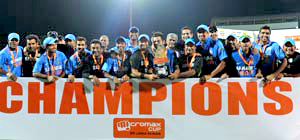
There was little to suggest from India’s aggression and application that this was a dead rubber. They were given a scare alright by a new-look Sri Lanka, but they kept their wits about them to finish the One-Day International series in the manner in which they had begun it – with an exciting victory.
Their 20-run win in the final game of five at the Pallekele International Cricket Stadium gave India a commanding and deserved 4-1 series victory, pulling them abreast of Australia on points at the top of the ICC ODI standings.
Sri Lanka’s two best batsmen were ruled out through injury, their most destructive limited-overs batsman was dismissed third ball, for a duck. Even so, they mounted a spirited run chase of a India’s massive 294 for 7, eventually being dismissed for 274 to go down all guns blazing.
Kumar Sangakkara was already out of the series with a broken finger, Mahela Jayawardene missed the final game with a sore back, and Tillakaratne Dilshan fell in just the second over. A young batting unit was put through a strong test, and it was a test it came through reasonably well, even if there was no icing on the cake in the shape of a victory.
Angelo Mathews couldn’t have asked for a better effort from his team in his first ODI as captain, if only on a stand-in basis. He reaffirmed his captaincy credentials by leading imaginatively in the afternoon, and saw Lahiru Thirimanne and Jeevan Mendis register their highest ODI scores respectively and give India a real scare through their 102-run sixth-wicket stand.
India, however, never panicked. Even with Thirimanne and Mendis blasting away against the quicker bowlers, they hung on in the belief that one wicket would bring another, and so it turned out. Irfan Pathan, who had helped Mahendra Singh Dhoni provide the Indian innings with the final thrust in the afternoon, was the star with 5 for 61, his second five-wicket haul, though R Ashwin too had an excellent outing, 0 for 37 from 9 overs on a day when the run rate hovered around the six mark.
India had whittled away at the Sri Lankan top-order, who all fell playing strokes. At 102 for 5, an early finish appeared imminent, but Thirimanne and Mendis entertained the crowd with commonsense batting that was, ironically, nipped by a needless mix-up. Thisara Perera then threw his bat around, but Pathan returned to clean up both Perera and Mendis in one over to all but signal the end.
India’s batting stint had been devoid of any great fluency or rhythm for the large part until Dhoni, with help from Pathan, cut loose towards the end. India, persisting with Rohit Sharma but bringing in Ajinkya Rahane, were well served by Gautam Gambhir’s sparkling strokeplay and Manoj Tiwary’s industrious, somewhat fortuitous half-century.
Gambhir had been the only batsman who had the measure of a pitch that afforded generous bounce to all-comers until Dhoni cut loose at the end. Fed a diet of legside half-volleys by Lasith Malinga, Gambhir whipped and flicked his way to a succession of early boundaries, unfazed either by Rahane’s cheap dismissal or Virat Kohli’s scratchy timing that was in stark contrast to the commanding form he has shown all series.
Nuwan Pradeep, express but erratic and quite a handful when he got it right, ended Kohli’s stint, then produced a good delivery to knock over Rohit. For a batsman so horribly out of sorts, Rohit would have been better advised playing straight; instead, attempting to work a Pradeep delivery pitched on off and middle to leg, he was beaten all ends up as the ball straightened to hit off-stump. It rounded off a miserable series that netted him just 13 runs in five innings.
Tiwary walked into a mini-crisis at 87 for 3, but stabilised the innings with Gambhir. The running was initially a little out of sync, but with time spent together, the understanding was better. Tiwary had his share of luck, too; on another day, he might have been adjudged caught behind when 46, then again on 56 but otherwise, he was quite enterprising, dominating the stand of 110 with Gambhir.
In the batting Power Play, India threatened to throw away the advantage in a strange passage of play when the runs kept coming but the wickets kept tumbling during a 12-ball burst that netted Sri Lanka 3 for 18. Malinga forced Tiwary to awkwardly fend off a bouncer to short third-man, then accounted for Suresh Raina first ball with another lifter.
Gambhir was done in by a knuckle ball from Sachithra Senanayake and India looked to be selling themselves short when Dhoni came to their rescue. Having averted the hat-trick, he was pinged on the helmet second ball by Malinga, but Dhoni exacted revenge with a brilliant counterattack. His cover-driving was of the highest order, but he also came up with delicate dabs to long-leg and characteristic brilliant running between the wickets alongside Pathan, during a stand of 77 in just 59 deliveries.





Comments
Add new comment